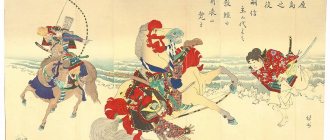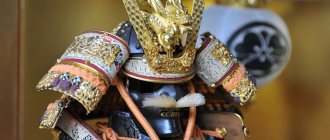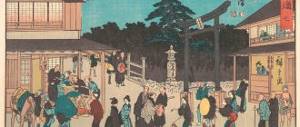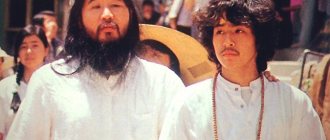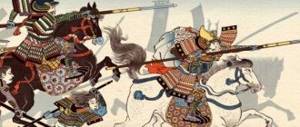The dominant religion of Japan is Shintoism. Buddhism is widespread almost equally with it. Many Japanese believers recognize themselves as followers of both directions at the same time. In 1886, Shintoism was recognized as the state religion, but this status has been lost since 1947. Communities of Christians, Muslims, and adherents of other movements are less numerous. In the past, many people in the country believed in animism and totemism. In addition to the main religions, there are several sectarian movements.
Shintoism is the main Japanese religious doctrine
Ancient Religions of Japan
The earliest religion among the indigenous Japanese is fetishism. Its object was a stone. Historians associate this with the development of technology - people learned to make tools from minerals. Pebbles became the first religious fetish. Already today, painted pebbles have been found in ancient temples, visually similar to Australian churinga. Both the Japanese and Australians believed that the stones contained children's souls. There are known legends about the stone near Funaho, a village in Kyushu. He called for rain and helped to conceive a child. In Fukuoka, two egg-shaped stones were worshiped. They believed that they attracted success and simplified childbirth.
Another evidence of the religion of fetishism in Japan is the Uwappara Shrine. It preserves stone pillars grouped into 3 blocks, forming a circle. To the north of them there are piles of stones piled above pits with coal. Historians suggest that the second fetish was fire.
Uvappara Sanctuary
Totemism
Totemism is a religion of ancient Japan, explained by the structure of the tribal community. With totemism, blood, family relationships of a person are transferred to nature. Associations appear with flora and fauna, on which the life of people in the Neolithic greatly depended. First, the cult of the Heavenly Deer, the elk, appeared. The Japanese believed that they were the first representatives of the fauna. Traces of this cult are found in ancient rituals of fortune-telling by reading a deer’s shoulder blade over the hearth. They are known not only to the Japanese, but also to the Mongols. Presumably, people saw off the souls of eaten animals on shell heaps. They believed that this way they would be able to return to give people food again.
Another evidence of ancient Japanese religions is the names of some areas. For example, Kumamoto Prefecture received its name due to the community's worship of bears. People believed in origin from this beast. These beliefs were especially strong among the ancestors of the Ainu. It is known that they buried bear bones along with human bones.
Japan's traditional religion contains echoes of the past. And today the inhabitants of the Land of the Rising Sun revere foxes, reptiles, and monkeys. There are traces of totemism in fairy tales - for example, about the phoenix Hoo, who combined the features of birds, snakes, fish and a turtle.
Trees revered in totemism:
- among the Ainu - elms;
- among the Japanese, Mongols, and Manchus - pine;
- among the Japanese - cypress, wild orange.
These trees were considered the patrons of the community, so it was under them that rituals and places for exchange were organized.
Pine is a sacred tree
Animism
Animism is an idea of the structure of the world, widespread in primitive society. The ancient Japanese believed in the spirituality of the world around them and the existence of spirits. Since the Yayoi era, a new religious cult of ancestors has appeared, the concepts of “oharai” (purification ritual), “kami” (god). This is how the foundations of Shinto are laid.
The central idea of animism is the soul as a life principle. This religion is characteristic not only of eastern countries - it is found in the works of Aristotle, the works of the Stoics, Thales of Miletus, Lucretius. The ethnographic term for religion was introduced by E. Tylor, who explained the origin of the movement with the reasoning of a certain savage philosopher who was looking for the causes of dreams and death.
Mount Haguro - the center of Japanese animism
Chanting the Samurai
At that time, samurai did not yet strive for the luxury and delicacy of palaces. They often had to engage in civil strife battles, repel attacks of foreign tribes, so the main thing for them was military valor, courage and honor. The warrior class liked the concepts of Zen Buddhism, because heaven can be achieved through discipline and one simple prayer. Gunka stories are written about warriors, conveying a feeling of anxiety, but devoid of the pomp of interiors and pomposity. The exploits of the samurai are described in scrolls, the cult of sword and armor appears, and Buddha statues are erected, executed with all severity. They wrote poems about how samurai go hunting, shoot and practice horseback riding. Nara art, expressed in the construction of the Kamakura Buddha statue, is especially held in high esteem. In medieval Japan, they are beginning to restore Nara temples that were destroyed during the war or those that are in dilapidated condition.
Modern religious composition of the country
The modern religious world of Japan is predominantly subject to the laws of Shinto and Buddhism. Separate surveys show that up to 84-96% of the country's believing population adhere to these movements. The state is characterized by syncretism, that is, many citizens follow two doctrines at once. The difficulty of counting is related to the associations of the population with specific temples. According to some researchers, only every third Japanese considers himself a believer.
The dominant beliefs in Japan are determined not only by the internal development of society, but also by external influence, in particular Chinese, which educated noble circles helped spread. The Way of Tao, the teachings of Confucius, Buddhism came to the Land of the Rising Sun from its mainland neighbor. This influence developed with internal religious practices, but did not replace them, so modern Japanese practice Shinto rituals, but often get married in Christian temples, and organize funerals in Buddhist ones. The 19th century became a new milestone in the history of religion in Japan - sects appeared. Most are unknown outside the country, but some have made news around the world due to their activism.
The peculiarity of beliefs in Japan is syncretism
Shintoists
When talking about Japanese religions, one usually thinks of Shinto shrines. Shintoism is a national traditional religion. It has no origin or founder, no sacred books. Shinto is the way of worshiping natural phenomena and the souls of ancestors. The supreme being is Amaterasu Omikami, the solar goddess, the ancestor of the imperial family. Shintoism is a national worldview that has shaped the uniqueness of the Japanese. This is the main religious movement, the name of which consists of the words “god” and “path”. This is a symbolic name that reflects the idea of the presence of spirit in each object. It is believed that these souls protect, protect, and help people.
There are approximately 80,000 temples in Japan; 27,000 clergy. Temples are divided into two areas: the prayer hall and the hoden, where the sacred object is kept. Rituals are carried out in temples and at home. Before the ritual, wash your hands thoroughly and rinse your mouth. When finishing, they drink a sip of sake - a symbol of the divine gift.
The main idea of Shinto is the harmony of man with nature. It is associated with Japanese philosophy, customs and culture of the country. Many perceive Shinto as an element of a specific national culture.
Fushimi Inari Shrine
Buddhists
Religious teaching originates from India, and came to Japan from China approximately in the 6th century. Some sources indicate other dates - IV, V centuries. At first, religion did not attract the attention of society. The turning point occurred in the 6th century, when Buddhism was adopted by nobles in the capital Asuka. The Soga clan chose a new religion and won the confrontation with the Minonobe, who supported the old religious system. For ordinary Japanese, Buddha was a foreign kami. The preachers did not fight the old teachings, but used them to their advantage. It is known that Buddhist temples were built only after the consent of Shinto deities. The buildings themselves were created according to Chinese prototypes. Sacred utensils were delivered from there.
In modern Japan, traditional and neo-Buddhism are distinguished. The first is the schools that have formed over many centuries. All traditional organizations are united by the All-Japan Buddhist Association, which includes about 60 groups. The largest group is Soto-shu. She owns about 14,700 temples. The clergy of these schools are rarely interested in social and political problems. Mostly these are conservatives who support the current system.
Buddha in Kamakura
Christians
Surveys show that there are just under 2 million Japanese Christians. The bulk falls on the western regions. 60% of those who recognize themselves as Christians are residents of the capital and Kanagawa. This is explained by the historical context: the port of Yokohama was accessible to foreigners.
Japanese Christianity dates back to 1549, when Francis Xavier arrived in Kagoshima. As a missionary, he began working in the south, baptizing several large feudal lords. The authorities did not approve of the new movement, religion was banned. This led to the formation of hidden Christians who secretly followed their chosen teaching.
At first, Christians were persecuted
Confucians
The trend of borrowing from China, which influenced all spheres of the cultural and social life of the Japanese, affected religion. One of the consequences was the spread of the teachings of Confucius. It became famous in Japan at an early stage of development thanks to the Koreans and Chinese who migrated to the islands. The newcomers brought with them sacred texts, customs and ways of life that influenced the indigenous population. In the 17th century, the church became a tool to help keep citizens obedient. This environment turned out to be favorable for the teachings of Confucius. In the form of Neo-Confucianism, the religion spread throughout the country.
The peculiarity of Confucianism is the unity of ethical norms, rules of behavior in society, and population management practices. It is often said that Confucianism cannot be called a religion, since in its characteristics it is rather a moral teaching.
Confucius with his students
Cultists
Only a few Japanese religious sects are known outside the country. Followers of even the largest sects are Japanese citizens; the number of foreigners among students is vanishingly small.
The most famous:
- Aum Shinrikyo;
- Soka Gakkai;
- Ray Yu Kai.
There is no exact information about the number of sects and the number of followers. All organizations are divided into groups:
- neo-Confucianism;
- neo-Shintoism;
- metabuddhism;
- religious agreement.
Most sects are neo-Buddhist, associated with Nichirenism. The Japanese call them new religions. Some researchers believe that in the 80s of the last century there were more than 20 neo-Buddhist directions in the Land of the Rising Sun, and their followers numbered in the millions.
Most Japanese sects are officially represented by lay communities. They are considered an integral part of the life of society and influence politics and economics. Syncretic sects appeared recently as an experiment in uniting Buddhism, Christianity, and philosophical movements.
Tokyo Soka Gakkai Memorial Hall
Believers of other religions
Islam in Japan is predominantly characteristic of emigrants. The main share are Tatars and Pakistanis. The mosque was first erected in 1905 in Osaka. The Muslim Tokyo Society was founded by the Bashkir Kurbangaliev. The Japanese Muslim school opened in 1927, and a year later the All-Japan Muslim Congress was held for the first time. Another 10 years later, the Tokyo mosque was opened. Islam as an active religion was recognized in the country in 1939. The number of followers is several hundred thousand people.
Other religious communities:
- Hindus (less than 30,000 believers);
- Baha'is (about 15,000 followers);
- Sikhs (about 2,000 people);
- Jains (just over 1,500 members);
- Jews (about 1,500 supporters).
About 10,000 Japanese declare themselves followers of primitive religious movements.
Representatives of Japanese Muslim society
Atheists
Atheism is spreading throughout the world. This growth is especially replaced by the results of sociological studies conducted in the United States. Many people claim that they do not believe in God, but do not call themselves atheists. Only every fourth non-believer considers himself to be part of this community.
Statistical studies show that Japan is second only to China in terms of irreligiosity. On average, 47% of Chinese are convinced atheists; in Japan, 31% consider themselves to be such.
A survey to assess irreligiosity showed that Japan ranks 2nd in the world, second only to China. About 16% of the country's population consider themselves believers (2% more than is typical for China).
Secular construction
Since the 16th century, feudal castles were built, capable of holding back the attacks of enemy armies behind their reliable walls. These multi-tiered structures were erected from wood, and stone foundations were laid at the base. Additionally, bastions and low walls were built around, and moats surrounded the perimeter of the castle. The most impressive castle of the time is Himeji Castle near Kobe, consisting of 80 different types of buildings.
The Edo era brought a calm after the destructive internecine wars. Instead of castles, the construction of palaces is taking place. They are one-story buildings, although the very first ones still have a fortification system, but later they are built like a garden and park ensemble. Traditionally, palace walls do not have structural functions, so they are replaced by openings or removable partitions. The builders tried to achieve maximum naturalness and unity with nature.
Buddhism in Japan
Several historical Chinese documents mention 5 monks who set sail to the islands. They carried with them religious images and sutras. The educators who landed in Japan told the population about the new teaching, called on them to abandon passions and attachments, putting peace of soul first. Japanese chronicles associate the emergence of Buddhism with Korean enlighteners.
The population of the country received the new teaching favorably, although some conflicts could not be avoided. Gradually, the situation escalated and resulted in a confrontation between two large clans striving for undivided power over the country. Religion became the formal reason for armed confrontation. Victory remained with the family that propagated Buddhism. From that moment on, the movement received official recognition.
The country's rulers supported the new religion. Prince Shotoku left personal notes on the sutras and contributed to the construction of the first temples, and Emperor Shomu established the status of a state religion. The development of Buddhism led to the identification of 6 Nara schools, whose ideology boiled down to the following:
- the world is unreal, follows from individual perception;
- life is suffering due to a cause that can be found and eliminated;
- the golden mean is the path of the adept;
- emptiness, the absence of one’s own nature, is the world’s basis.
Buddhism in Japan has absorbed local customs, so it is very different from Chinese. It developed in conditions of isolation, so the ancient provisions were preserved in better shape. Japanese adherents have the right to judge for themselves what is wise and eternal, while Chinese teaching takes into account only the collective and the indisputable authority of the teacher.
Japanese Buddhism merged with Shintoism. This led to the emergence of the dual path of spirits - Rebu Shinto. The Shingon sect, which promoted the cult of Buddha Vairocana, the symbol of the Universe, had a strong influence. Shinto kami were perceived as Buddhas, Amaterasu - Vairochan.
Over the centuries, the role of the clergy became greater and its influence on power became stronger. The Tendai sect had the main privileges. First it was used by emperors, then by the shogunate. Political changes led to religious changes and the development of Zen Buddhism. Zen spread among the samurai, among the elite of society. The rituals and spiritual practices of that era became the basis for the development of all areas of public life - from the tea ceremony to art.
Todai-ji in Nara
Historical information
As the history of medieval Japan tells, the very first mentions of the country’s rulers date back to the 7th century BC. e. Although scientists claim that the first state arose here only in the 3rd–4th centuries on the territory of the Yamato tribe. Over the next three centuries, the Yamato leaders were able to conquer the tribes living on the islands of Honshu and Kushu, and their attacks on the lands of Korea are also known.
Local residents are still confident in the divine origin of the imperial dynasty. According to legend, the sun goddess presented signs of power to the first emperor. Although the ruler enjoys boundless respect, he almost never had real power.
As history tells us, medieval Japan was always ruled by representatives of a few of the richest and most respected families, passing power from generation to generation. In 645, supporters of the emperor staged a coup, as a result of which the Soga clan was removed from rule. Such a step should strengthen state power so that all residents obey the same laws, and local authorities unconditionally carry out the orders of the emperor.
Features of Confucianism in Japan
Confucianism is an ethical, philosophical movement that appeared 2.5 millennia ago in China. In Japan, it underwent changes as it developed outside the conditions of Chinese conformity. The spread of the teachings of Confucius in the Land of the Rising Sun is due to the closeness of its provisions to the traditional cult of ancestors.
Confucianism appeared in Japan later than Buddhism, so the preachers of the new path met with a wary attitude. It combines teaching, religion; is aimed at moral teaching of youth, showing respect for elders, and love of humanity.
Confucianism in Japan is associated with the policies of the Tokugawa shogunate in the 17th century. The movement to centralize power turned the church into an instrument to ensure the obedience of ordinary people. Neo-Confucianism, promoted by the shoguns, seemed to be a source of power through the ideals of devotion to a teacher, an elder. Its main idea is the division of society into insignificant and noble, which are characterized by 5 features:
- humanism;
- courtesy;
- intelligence and education;
- call of Duty;
- loyalty.
Equally important in Confucianism is respectfulness, one of the basic human virtues. In the Middle Ages in Japan, Confucian literature of an edifying nature was formed. For Japanese followers, Confucius himself, from a Chinese sage, became a representative of Eastern wisdom, which the whole world will eventually come to know.
Confucian ideas have permeated Japanese society since the Tokugawa period. They defined adherence to the canons, humility, respect, relationships in society, generosity, peace and harmony, economy and moderation in life. These canons determined the importance of agriculture and silk production - areas that provided the population with clothing and food. Important Confucian dogmas:
- learning is fundamentally important for a person;
- it is permissible to follow only the true path;
- it is important to explain the laws to everyone;
- Having chosen a business, you need to work hard;
- To protect the younger generation from bad deeds, moral teachings and teachings are enough;
- false accusations are unacceptable;
- harboring fugitives is illegal;
- taxes must be paid in full;
- to combat crime it is necessary to unite the efforts of the community;
- suppression of anger elevates the personality.
These postulates influenced public consciousness and became the basis for the formation of behavioral stereotypes. For modern Japanese, these dogmas have lost the significance characteristic of medieval residents, but continue to largely regulate social processes.
Confucianism came to Japan later than Buddhism
Law concept
The very first constitution of Shotoku-taishi, dating back to the early Taika era in 604, is known. The concept of law at that time was poorly defined, one can only say about the norms of punishment, designated by the concepts of punishment or God's wrath. It was necessary to follow certain standards of behavior called giri. There were several giris in the country: father and son, older and younger brothers, husband and wife. Also highlighted were weights that were not related to family relationships, that is, between traders and buyers, master and subordinate, and the like. They were followed as unwritten laws, taking into account condemnation in case of bad or incorrect attitude towards loved ones or subordinates.
Own customary law (buke-ho) was designated in the military caste (buke or samurai). Within the military community there was a code of rules based on the exclusive loyalty of the subordinate to his overlord. If the latter showed excessive cruelty, then the vassal had no rights to protection and was entirely dependent on the will of his master. A little later, against the arbitrariness of the overlords, a special Collection of customs of the military caste was compiled, which indicated the norms of criminal law and the code of honor for the military.
In medieval Japan, law prescribed only one thing - the subordination of the lower strata of the population to the masters higher in the hierarchy. In the state, each social group had clearly defined functions; the clarification of responsibilities was described in collections of ritsu-ryo. The term “ritsu” indicated repressive norms, and the term “ryo” indicated administrative norms.
Predominant religion
Research to determine the dominant religion and the number of believers was organized by the Japanese Agency for Cultural Affairs. Surveys have shown that the number of believers is more than 180 million. This figure is noticeably higher than the official number of Japanese citizens, since many adhere to several directions at the same time. Among those surveyed, the majority declared adherence to Buddhism - almost 88 million. Shintoism as a religious doctrine was mentioned by about 85 million.
The syncretism characteristic of the Japanese does not allow one to strictly identify a single dominant religion. Both Shintoism and Buddhism are equally revered and respected, and most Japanese believers adhere to both schools simultaneously.
In Japan there is no prejudice against holidays that come from other religions. Many citizens celebrate the last day of the year at a Buddhist shrine, having previously celebrated Christian Christmas or Halloween. On the first day of the New Year, it is customary to make a pilgrimage to a Shinto shrine. Buddhist and Shinto prayer corners are installed in homes.
Syncretism is a feature of Japan
Political structure
From the 12th century the feudal hierarchy became stronger. Due to feudal fragmentation, the country is in a state of constant internecine strife. Even after the establishment of the supreme power of the shoguns, clashes between small feudal lords did not stop. Among such conditions, the worldview of a samurai is created, ready to sacrifice himself to his overlord. The samurai becomes a model of courage, honor and loyalty.
After the appearance of large feudal farms, the formation and growth of cities began. A city began to be built near the ruler's castle, where the trade and craft population predominated. Large latifundia are replacing private landholdings.
Magic and religion of Japan
Shinto is the ancient religious way of the Japanese. The national religion says: the emperor is the grandson of the Sun. In Shinto there is the concept of the rice man (the god of Food), as well as the deities of Water, Fire, and the reproductive member. The Japanese especially believe in the power of the demonic fox Inari. Stories and legends speak of her ability to modify the world around her and herself.
Modern Everyday Japanese Magic:
- those who want to attract wealth acquire a wooden amulet in the form of a kite;
- a fan decorated with fiery tongues and wise words protects against fire;
- a prediction purchased from a priest will come true if you tie it to a tree branch;
- three Nikko monkeys made from wood will ward off demons and diseases.
In former times in Japan there were anmiyoji - magicians and advisers to rulers.
The main modern magical action is the mark. A five-pointed star enclosed in a circle has a special magical effect. For writing, they used special paper, which was then folded along strictly defined lines. Paper is the second magical object. The third is sound. The main Japanese spell is the human name. The Japanese believe that magical power lies in the heart.
Three monkeys from Nikko
Architectural preferences
What is special about the architecture of medieval Japan? In the 12th century, Buddhist temples began to be built among picturesque nature. Nature was considered a deity, so architectural structures had to fit harmoniously into the surrounding landscape. Estates and palaces were built in the form of a rectangle, with its southern side facing the square, framed on both sides by galleries with outbuildings. On the southern part of the building they always tried to arrange a landscape garden consisting of lakes, rocks, bridges and islands. Gardens should evoke thoughts of solitude, set the mood for silence and a calm mood. Instead of the rapid flow of a waterfall, they preferred to build ponds with stagnant water, and delicate lotus flowers should sway on the surface. The charm of a secluded garden was created in Heian parks, when at every turn of the path a change in the landscape awaited. Instead of air bridges, smooth stones appeared that created mosaic paintings. Gardens that decorate all four seasons are popular with the nobility.
The most popular places at that time were palaces, castles and houses for tea ceremonies. There is a tendency towards simple architectural lines. Wooden structures were not always covered with paint. Knots on the surface of the wood were used as decorative elements. The buildings were erected in the form of a rectangular pavilion surrounded by a gallery, and the roof should have a curved shape. Multi-tiered pagodas are being built, although they are small in size. If the building is painted, do not use more than one or two colors. In Japan, the very first sacred temples were considered to be storerooms where rice supplies were stored. The pantries were raised on high pillars to prevent moisture from spoiling the rice. The first temples were built like grain storehouses. The climate in Japan is quite humid, but wooden temples have survived to this day. They owe this longevity to the Japanese custom of dismantling sacred temples every 20 years and building new ones in that place from a different material.
What is Shintoism
The Shinto culture originates thousands of years ago - at the advent of a new era. In a sense, it can be called the oldest religion known to us, which has its adherents in modern times.
Formed on the basis of animistic ancient beliefs, Shintoism has now retained many of the features characteristic of primitive societies. This distinguishes it from other cultures where the animistic stage was passed and forgotten a long time ago.
Having absorbed some knowledge from neighboring religions, Shintoism was finally established by the 8th century. The main characteristic of religion can be called its teaching about the spiritual nature of all things.
The name "Shintoism" comes from the word "Shinto", which means "sacred way" or "way of the gods" ("way of the kami"). It is noteworthy that Eastern religions are characterized by the metaphor of the path. Buddhism and Taoism also turn to this symbol.
Painting
Since the 7th century, the painting of medieval Japan has remained very simple. The level of craftsmanship can be judged by the paintings decorating the Tamamushi Ark from Horyuji Temple. The author painted the ark with yellow, red and green paint on a black base. As Buddhism spread, more and more places of worship appeared, so there was a demand for highly skilled artists. Now the masters collectively worked on one drawing according to their specialization. One artist just sketched, the second did the coloring, and the third traced the outline of the finished painting. On emakimono panels in the 8th century, the designs are symbolic in nature; there is no dynamics here. Landscape and genre painting begins to develop. A striking example is the painted screen “Woman with Bird Feathers”, where the lines become smoother and lighter, creating an expressive image. Since the 9th century, Buddhist painting has been developing, which is characterized by depicting a mandala. To draw a mandala, more expensive materials were used, such as silver and gold.
At the end of the 16th century, a number of painting schools appeared: Tosa, Soga, Kano, Kaiho, Unkoku. During this period, many unique paintings were created, belonging not only to famous masters, but also to unknown artists.
